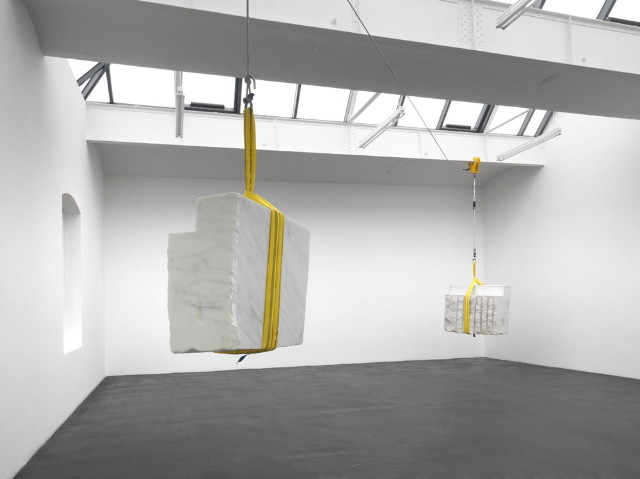Simon Starling
02 May - 27 Jun 2009

Simon Starling, The Long Ton, 2009
1 chinese marble block, 1 Carrara marble block,
pulleys system, clamps, rope, shackles
chinese marble block: 90 x 120 x 50 cm
Carrara marble block: 59 x 74 x 31 cm
1 chinese marble block, 1 Carrara marble block,
pulleys system, clamps, rope, shackles
chinese marble block: 90 x 120 x 50 cm
Carrara marble block: 59 x 74 x 31 cm
simon starling
the long ton
2 may - 27 june 2009
We would like to draw your attention to our fourth solo exhibition of works by Simon Starling (born 1967), which will open on 1 May and be on view at our gallery until 27 June 2009.
Starling’s installation “The Long Ton”, like a number of previous works that connect and collapse geographically remote situations, takes the form of a simple but startling balancing act. Two rough-cut white lumps of marble hang one off the other. Through the use of a rudimentary pulley system, the larger of the two stones, an exotic import from China weighing just over one tonne is kept from falling to the floor by approximately 250 kg of Italian Carrara marble. On closer inspection it is clear that the two stones have exactly the same form, the Italian stone having been precision machined with data scanned from the larger Chinese stone. When viewed from the entrance to the exhibition space “The Long Ton” creates the illusion that the two stones are comparable in both shape and size - effectively confusing an understanding of the space between the two. Furthermore, despite its long voyage to Europe, the ’long ton’ of Chinese marble has a similar market value to a European stone one-quarter its weight.
Accompanying the installation are two additional works: a sculpture and a set of silver prints. The sculpture, “Archaeopteryx Lithographica”, takes its name from one of the most important fossil-finds in history. This singular sculptural work, a lithographic stone prepared for printing, explores a moment in the 19th century when the evolution of offset printing directly impacted our understanding of the fundamentals of evolution within nature. The discovery of an ancient fossilized feather in Solnhofen, Germany, was the direct consequence of quarrying activities that resulted from the invention and rapid success of lithographic printing.
In his new photographic set of eight prints, Starling, recently described as a poetic investigator of hidden lives and objects, explores two stainless steel sculptures produced by Chinese manpower in a series of close-ups, thus reproducing a tridimensional enlargement of a silver particle. Having won the Turner Prize in 2005 Starling has recently shown at the Temporäre Kunsthalle in Berlin. Other solo exhibitions by the artist are on view at MASSMoCA (13 December 2008 - 31 October 2009) and will be on show at MAC/VAL (17 September – 27 December 2009) and Parc Saint Leger (19 September - 20 November 2009). Starling will also be present at this summer’s 53rd International Art Exhibition Venice Biennale with a major installation.
For further information and press images please contact Karin von Hülsen, tel +49 30 2887 7277, fax +49 30 2887 7278 or by email: mail@neugerriemschneider.com.
the long ton
2 may - 27 june 2009
We would like to draw your attention to our fourth solo exhibition of works by Simon Starling (born 1967), which will open on 1 May and be on view at our gallery until 27 June 2009.
Starling’s installation “The Long Ton”, like a number of previous works that connect and collapse geographically remote situations, takes the form of a simple but startling balancing act. Two rough-cut white lumps of marble hang one off the other. Through the use of a rudimentary pulley system, the larger of the two stones, an exotic import from China weighing just over one tonne is kept from falling to the floor by approximately 250 kg of Italian Carrara marble. On closer inspection it is clear that the two stones have exactly the same form, the Italian stone having been precision machined with data scanned from the larger Chinese stone. When viewed from the entrance to the exhibition space “The Long Ton” creates the illusion that the two stones are comparable in both shape and size - effectively confusing an understanding of the space between the two. Furthermore, despite its long voyage to Europe, the ’long ton’ of Chinese marble has a similar market value to a European stone one-quarter its weight.
Accompanying the installation are two additional works: a sculpture and a set of silver prints. The sculpture, “Archaeopteryx Lithographica”, takes its name from one of the most important fossil-finds in history. This singular sculptural work, a lithographic stone prepared for printing, explores a moment in the 19th century when the evolution of offset printing directly impacted our understanding of the fundamentals of evolution within nature. The discovery of an ancient fossilized feather in Solnhofen, Germany, was the direct consequence of quarrying activities that resulted from the invention and rapid success of lithographic printing.
In his new photographic set of eight prints, Starling, recently described as a poetic investigator of hidden lives and objects, explores two stainless steel sculptures produced by Chinese manpower in a series of close-ups, thus reproducing a tridimensional enlargement of a silver particle. Having won the Turner Prize in 2005 Starling has recently shown at the Temporäre Kunsthalle in Berlin. Other solo exhibitions by the artist are on view at MASSMoCA (13 December 2008 - 31 October 2009) and will be on show at MAC/VAL (17 September – 27 December 2009) and Parc Saint Leger (19 September - 20 November 2009). Starling will also be present at this summer’s 53rd International Art Exhibition Venice Biennale with a major installation.
For further information and press images please contact Karin von Hülsen, tel +49 30 2887 7277, fax +49 30 2887 7278 or by email: mail@neugerriemschneider.com.
